Papers by Ley Killeya-Jones

PloS one, 2016
The low transcriptionally efficient short-allele of the 5HTTLPR serotonin transporter polymorphis... more The low transcriptionally efficient short-allele of the 5HTTLPR serotonin transporter polymorphism has been implicated to moderate the relationship between the experience of stressful life events (SLEs) and depression. Despite numerous attempts at replicating this observation, results remain inconclusive. We examined this relationship in young-adult Non-Hispanic white males and females between the ages of 22 and 26 (n = 4724) participating in the National Longitudinal Study of Adolescent to Adult Health (Add Health) with follow-up information every six years since 1995. Linear and logistic regression models, corrected for multiple testing, indicated that carriers of one or more of the S-alleles were more sensitive to stress than those with two L-alleles and at a higher risk for depression. This relationship behaved in a dose-response manner such that the risk for depression was greatest among those who reported experiencing higher numbers of SLEs. In post-hoc analyses we were not ab...

Journal of the American Geriatrics Society, 2015
To evaluate pneumococcal immunization in older adults living in retirement communities and to mea... more To evaluate pneumococcal immunization in older adults living in retirement communities and to measure nasopharyngeal carriage of Streptococcus pneumoniae to better assess the potential for herd protection from the 13-valent pneumococcal conjugate vaccine (PCV-13) in these settings. Cross-sectional observational study of adults aged 65 and older living in retirement communities to determine coverage with 23-valent pneumococcal vaccine (PPSV-23), coverage with PCV-13 in immuncompromised individuals according to 2012 Advisory Committee on Immunization Practices (ACIP) guidelines, and nasopharyngeal carriage of S. pneumoniae. Two retirement communities in North Carolina. Older adults recruited between December 2013 and April 2014 (N = 21, 64.8% female, mean age 81.4). A survey was used to assess chronic illnesses, immunization history, and potential risk factors for pneumococcal carriage; a chart review was used to confirm immunization history and abstract chronic conditions; and a nasopharyngeal swab was collected and cultured for S. pneumoniae. Eighty-seven percent of participants reported receiving PPSV-23 since age 65. Of the 16.2% of participants with an immunocompromising condition, only one had received PCV-13. Nasopharyngeal carriage with S. pneumoniae was detected in 1.9% (95% confidence interval = 0.0-3.8%) of participants. In this select sample, PPSV-23 coverage was high, but adherence to the ACIP recommendation for PCV-13 in immunocompromised groups was low. Nasopharyngeal carriage of S. pneumoniae was present, although infrequent, suggesting that immunization with PCV-13 could provide an individual benefit and a small degree of herd protection.

Substance abuse treatment, prevention, and policy, 2006
The only national drug abuse prevention delivery system that supports the rapid diffusion of new ... more The only national drug abuse prevention delivery system that supports the rapid diffusion of new prevention strategies and includes uniform training and credentialing of instructors who are monitored for quality implementation of prevention programming is the Drug Abuse Resistance Education network (D.A.R.E.) linking community law enforcement to schools. Analysis of the organizational structure and function of D.A.R.E. provides an understanding of the essential parameters of this successful delivery system that can be used in the development of other types of national infrastructures for community-based prevention services. Information regarding organizational structure and function around funding issues, training, quality control and community relationships was gathered through telephone surveys with 50 state D.A.R.E. coordinators (including two major cities), focus groups with local D.A.R.E. officers and mentors, and interviews with national D.A.R.E. office staff. The surveys help...
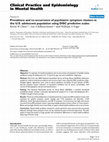
Clinical practice and epidemiology in mental health : CP & EMH, Jan 28, 2005
To estimate 12-month prevalence and co-occurrence of symptoms of specific mental problems among U... more To estimate 12-month prevalence and co-occurrence of symptoms of specific mental problems among US adolescents (12-17 years) by age, sex and racial/ethnic subgroups. Data from the 2000 National Household Survey of Drug Abuse (NHSDA) adolescent sample are used to estimate prevalence and co-occurrence rates using the DISC predictive scales. Multiple logistic regressions were used to derive significant correlates of each domain of DPS-derived symptom cluster indicators of psychiatric problems and of severe comorbidity, with control of demographics and environmental factors. The National Household Survey on Drug Abuse (NHSDA), a national household probability sample, includes a nationally representative sample of 12-17 year-old adolescents (N = 19,430), through in-home surveys. Three out of five adolescents screened positive for at least one DPS symptom cluster with estimates for specific symptom cluster ranging over 9.7% (substance use disorder), 13.4% (affective), 36.3% (disruptive-be...

Annals of epidemiology, 2014
We investigated understudied biomarker-based diabetes among young US adults, traditionally charac... more We investigated understudied biomarker-based diabetes among young US adults, traditionally characterized by low cardiovascular disease risk. We examined 15,701 participants aged 24 to 32 years at Wave IV of the National Longitudinal Study of Adolescent Health (Add Health, 2008). The study used innovative and relatively noninvasive methods to collect capillary whole blood via finger prick at in-home examinations in all 50 states. Assays of dried blood spots produced reliable and accurate values of HbA1c. Reliability was lower for fasting glucose and lowest for random glucose. Mean (SD) HbA1c was 5.6% (0.8%). More than a quarter (27.4%) had HbA1c-defined prediabetes. HbA1c was highest in the black, non-Hispanic race/ethnic group, inversely associated with education, and more common among the overweight/obese and physically inactive. The prevalence of diabetes defined by previous diagnosis or use of antidiabetic medication was 2.9%. Further incorporating HbA1c and glucose values, the p...

Behavior Genetics, 2014
Here we provide a detailed description of the genome-wide information available on the National L... more Here we provide a detailed description of the genome-wide information available on the National Longitudinal Study of Adolescent to Adult Health (Add Health) sibling pair subsample (Harris et al. in Twin Res Hum Genet 16:391-398, 2013). A total of 2,020 samples were genotyped (including duplicates) arising from 1946 Add Health individuals from the sibling pairs subsample. After various steps for quality control (QC) and quality assurance (QA), we have high quality genome-wide data available on 1,888 individuals. In this report, we first highlight the QC and QA steps that were taken to prune the data of poorly performing samples and genetic markers. We further estimate the pairwise biological relationships using genome-wide data and compare those estimates to the assumed relationships in Add Health. Additionally, using genome-wide data from known regional reference populations from Europe, West Africa, North and South America, Japan and China, we estimate the relative genetic ancestry of the respondents. Finally, rather than conducting a traditional cross-sectional genome-wide association study (GWAS) of body mass index (BMI), we opted to utilize the extensive publicly available genome-wide information to conduct a weighted GWAS of longitudinal BMI while accounting for both family and ethnic variation.

Behavior Genetics, 2014
Simple sequence repeats (SSRs) are one of the earliest available forms of genetic variation avail... more Simple sequence repeats (SSRs) are one of the earliest available forms of genetic variation available for analysis and have been utilized in studies of neurological, behavioral, and health phenotypes. Although findings from these studies have been suggestive, their interpretation has been complicated by a variety of factors including, among others, limited power due to small sample sizes. The current report details the availability, diversity, and allele and genotype frequencies of six commonly examined SSRs in the ethnically diverse, population-based National Longitudinal Study of Adolescent Health. A total of 106,743 genotypes were generated across 15,140 participants that included four microsatellites and two di-nucleotide repeats in three dopamine genes (DAT1, DRD4, DRD5), the serotonin transporter, and monoamine oxidase A. Allele and genotype frequencies showed a complex pattern and differed significantly between populations. For both di-nucleotide repeats we observed a greater allelic diversity than previously reported. The availability of these six SSRs in a large, ethnically diverse sample with extensive environmental measures assessed longitudinally offers a unique resource for researchers interested in health and behavior.
Prevention Science, 2007
Two competing hypotheses were tested concerning the associations between current alcohol and ciga... more Two competing hypotheses were tested concerning the associations between current alcohol and cigarette use and measures of individual, group and network peer standing in an ethnically-diverse sample of 156 male and female adolescents sampled at two time points in the seventh grade. Findings lent greater support to the person hypothesis, with early regular substance users enjoying elevated standing amongst their peers and maintaining this standing regardless of their maintenance of or desistance from current use later in the school year. In the fall semester, users (n=20, 13%) had greater social impact, were described by their peers as more popular, and were more central to the peer network than abstainers (i.e., those who did not report current use).
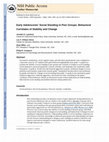
Journal of Youth and Adolescence, 2009
Sociometric nominations, social cognitive maps, and self-report questionnaires were completed in ... more Sociometric nominations, social cognitive maps, and self-report questionnaires were completed in consecutive years by 327 students (56% girls) followed longitudinally from grade 7 to grade 8 to examine the stability of social standing in peer groups and correlates of changes in social standing. Social preference, perceived popularity, network centrality, and leadership were moderately stable from grade 7 to grade 8. Alcohol use and relational aggression in grade 7 predicted changes in social preference and centrality, respectively, between grade 7 and grade 8, but these effects were moderated by gender and ethnicity. Changes in social standing from grade 7 to grade 8 were unrelated to grade 8 physical aggression, relational aggression, and alcohol use after controlling for the grade 7 corollaries of these behaviors. Results are discussed in terms of their implications for understanding links between social standing and problem behaviors during adolescence.

Journal of School Psychology, 2007
We examined the relations between group context and self-and other-perceptions of aggressive beha... more We examined the relations between group context and self-and other-perceptions of aggressive behavior in an ethnically-diverse sample of 168 male and female grade 7 adolescents. We used selfand peer-reports of aggression in high-and average-aggressive mixed-sex and same-sex cliques to examine whether group members would assimilate their self-report of aggression to the aggression report of their peers by way of perceived homophily or, conversely, engage in contrast and see their level of aggression as comparatively low in the face of high-aggression peers. Among boys in mixedsex groups, comparison with highly-aggressive others resulted in a self-perception of lower levels of aggression than those perceived by their peers. Conversely, girls in mixed-sex groups reported their own levels of aggression to be higher than those perceived by their peers. We interpret these findings in terms of the notion of "norm narrowing": rather than being set by the larger social environment, such as the school, norms are more narrowly determined within one's immediate peer group.
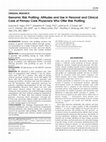
Journal of General Internal Medicine, 2011
BACKGROUND: Genomic risk profiling involves the analysis of genetic variations linked through sta... more BACKGROUND: Genomic risk profiling involves the analysis of genetic variations linked through statistical associations to a range of disease states. There is considerable controversy as to how, and even whether, to incorporate these tests into routine medical care. OBJECTIVE: To assess physician attitudes and uptake of genomic risk profiling among an 'early adopter' practice group. DESIGN: We surveyed members of MDVIP, a national group of primary care physicians (PCPs), currently offering genomic risk profiling as part of their practice. POPULATION: All physicians in the MDVIP network (N =356) RESULTS: We obtained a 44% response rate. One third of respondents had ordered a test for themselves and 42% for a patient. The odds of having ordered personal testing were 10.51-fold higher for those who felt well-informed about genomic risk testing (p < 0.0001). Of those who had not ordered a test for themselves, 60% expressed concerns for patients regarding discrimination by life and longterm/disability insurers, 61% about test cost, and 62% about clinical utility. The odds of ordering testing for their patients was 8.29-fold higher among respondents who had ordered testing for themselves (p < 0.0001). Of those who had ordered testing for patients, concerns about insurance coverage (p = 0.014) and uncertain clinical utility (p = 0.034) were associated with a lower relative frequency of intention to order testing again in the future. CONCLUSIONS: Our findings demonstrate that respondent familiarity was a key predictor of physician ordering behavior and clinical utility was a primary concern for genomic risk profiling. Educational and interpretive support may enhance uptake of genomic risk profiling.

Journal of Ethnicity in Substance Abuse, 2006
To examine community/racial differences in adolescent marijuana use and the variations in factors... more To examine community/racial differences in adolescent marijuana use and the variations in factors underlying the observed differences, a questionnaire survey study was conducted with 9th to 12th graders (n = 1,936) from two communities in New Jersey. Marijuana use was significantly higher among suburban (mostly White) students than among their urban (mostly Black) counterparts. Significant differences in marijuana use between the two community sub-samples were explained by differences in type of risk factors, mean number of risk factors, and the strength of the association (slopes) between risk factors and marijuana use. Social-environmental factors (including positive after-school activities and negative peer influences) and, to a lesser degree, family factors (including family income, parental and sibling drug use), accounted for most community/racial differences in marijuana use.
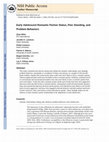
The Journal of Early Adolescence, 2009
This study examined associations among early adolescent romantic relationships, peer standing, pr... more This study examined associations among early adolescent romantic relationships, peer standing, problem behaviors, and gender as a moderator of these associations, in a sample of 320 seventhgrade students. Popular and controversial status youth were more likely to have a romantic partner, whereas neglected status youth were less likely to have a romantic partner. Similarly, youth perceived as conventional and unconventional leaders were also more likely to have a romantic partner than were non-leaders. Youth who had a romantic partner drank more alcohol and were more aggressive than were youth who did not have a romantic partner. Among those youth who had romantic partners, those who reported having more deviance-prone partners were themselves more likely to use alcohol and to be more aggressive, and those who engaged in deviant behavior with their partners used more alcohol. However, these associations varied somewhat by gender. These findings underscore the salience of early romantic partner relationships in the adjustment of early adolescents.
Epidemiology, 2011
W e welcome Sorlie's 1 appraisal of the Add Health-NHANES discordance. His tenure within the NHLB... more W e welcome Sorlie's 1 appraisal of the Add Health-NHANES discordance. His tenure within the NHLBI, 2 its longstanding sponsorship of NHANES, and his intimate knowledge of blood pressure methodology within NHANES indicate his command of NHANES' strengths.
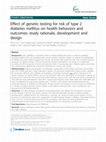
BMC Health Services Research, 2012
Background: Type 2 diabetes is a prevalent chronic condition globally that results in extensive m... more Background: Type 2 diabetes is a prevalent chronic condition globally that results in extensive morbidity, decreased quality of life, and increased health services utilization. Lifestyle changes can prevent the development of diabetes, but require patient engagement. Genetic risk testing might represent a new tool to increase patients' motivation for lifestyle changes. Here we describe the rationale, development, and design of a randomized controlled trial (RCT) assessing the clinical and personal utility of incorporating type 2 diabetes genetic risk testing into comprehensive diabetes risk assessments performed in a primary care setting. Methods/Design: Patients are recruited in the laboratory waiting areas of two primary care clinics and enrolled into one of three study arms. Those interested in genetic risk testing are randomized to receive either a standard risk assessment (SRA) for type 2 diabetes incorporating conventional risk factors plus upfront disclosure of the results of genetic risk testing ("SRA+G" arm), or the SRA alone ("SRA" arm). Participants not interested in genetic risk testing will not receive the test, but will receive SRA (forming a third, "no-test" arm). Risk counseling is provided by clinic staff (not study staff external to the clinic). Fasting plasma glucose, insulin levels, body mass index (BMI), and waist circumference are measured at baseline and 12 months, as are patients' self-reported behavioral and emotional responses to diabetes risk information. Primary outcomes are changes in insulin resistance and BMI after 12 months; secondary outcomes include changes in diet patterns, physical activity, waist circumference, and perceived risk of developing diabetes.

Biological Psychiatry, 2014
Maltreatment by an adult or caregiver during childhood is a prevalent and important predictor of ... more Maltreatment by an adult or caregiver during childhood is a prevalent and important predictor of antisocial behaviors in adulthood. A functional promoter polymorphism in the monoamine oxidase A (MAOA) gene has been implicated as a moderating factor in the relationship between childhood maltreatment and antisocial behaviors. Although there have been numerous attempts at replicating this observation, results remain inconclusive. We examined this gene-environment interaction hypothesis in a sample of 3356 white and 960 black men (aged 24-34) participating in the National Longitudinal Study of Adolescent Health. Primary analysis indicated that childhood maltreatment was a significant risk factor for later behaviors that violate rules and the rights of others (p &amp;amp;amp;amp;amp;amp;amp;amp;amp;amp;amp;amp;amp;amp;amp;amp;amp;amp;amp;amp;amp;amp;amp;amp;amp;amp;amp;amp;amp;amp;amp;amp;amp;amp;amp;amp;amp;amp;amp;amp;amp;amp;amp;amp;amp;amp;amp;amp;amp;amp;amp;amp;amp;amp;amp;amp;amp;amp;amp;amp;amp;amp;amp;amp;amp;amp;lt; .05), there were no main effects of MAOA genotype, and MAOA genotype was not a significant moderator of the relationship between maltreatment and antisocial behaviors in our white sample. Post hoc analyses identified a similar pattern of results among our black sample in which maltreatment was not a significant predictor of antisocial behavior. Post hoc analyses also revealed a main effect of MAOA genotype on having a disposition toward violence in both samples and for violent convictions among our black sample. None of these post hoc findings, however, survived correction for multiple testing (p &amp;amp;amp;amp;amp;amp;amp;amp;amp;amp;amp;amp;amp;amp;amp;amp;amp;amp;amp;amp;amp;amp;amp;amp;amp;amp;amp;amp;amp;amp;amp;amp;amp;amp;amp;amp;amp;amp;amp;amp;amp;amp;amp;amp;amp;amp;amp;amp;amp;amp;amp;amp;amp;amp;amp;amp;amp;amp;amp;amp;amp;amp;amp;amp;amp;amp;gt; .05). Power analyses indicated that these results were not due to insufficient statistical power. We could not confirm the hypothesis that MAOA genotype moderates the relationship between childhood maltreatment and adult antisocial behaviors.
Clinical Practice and …, 2005
© 2005 Chen et al; licensee BioMed Central Ltd. This is an Open Access article distributed under ... more © 2005 Chen et al; licensee BioMed Central Ltd. This is an Open Access article distributed under the terms of the Creative Commons Attribution License (http://creativecommons.org/licenses/by /2.0), which permits unrestricted use, distribution, and reproduction in any medium, ...

American Journal of Public Health, 2013
The influence of genetic factors on health and behavior is conditioned by social, cultural, insti... more The influence of genetic factors on health and behavior is conditioned by social, cultural, institutional, and physical environments in which individuals live, work, and play. We encourage studies supporting multilevel integrative approaches to understanding these contributions to health, and describe the Add Health study as an exemplar. Add Health is a large sample of US adolescents in grades 7 to 12 in 1994-1995 followed into adulthood with 4 in-home interviews and biomarker collections, including DNA. In addition to sampling multiple environments and measuring diverse social and health behavior, Add Health features a fully articulated behavioral genetic sample (3000 pairs) and ongoing genotyping of 12,000 archived samples. We illustrate approaches to understanding health through investigation of the interplay among biological, psychosocial, and physical, contextual, or cultural experiences.








Uploads
Papers by Ley Killeya-Jones